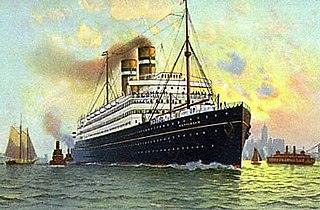SS Fazilka was a British India Steam Navigation Company (BI) steamship. She was built in England in 1890, operated mostly in the Indian Ocean, and was wrecked in the Nicobar Islands in 1919. She was a troop ship in the Second Boer War and the First World War. From 1901 to 1907 she took Indian indentured labourers to Fiji.

SS Antilla was a Hamburg America Line (HAPAG) cargo ship that was launched in 1939 and scuttled in 1940.
Persier was a 5,382 GRT cargo ship which was built in 1918 as War Buffalo for the British Shipping Controller. In 1919, she was sold to Belgium and renamed Persier. Between 1934 and 1941 she also held a passenger certificate. She was driven ashore on the Icelandic coast in a storm in February 1941 which put her out of action for two years. Returned to service in February 1943, she served until 11 February 1945, when she was torpedoed and sunk by U-1017 with the loss of 20 crew.
The first USS Pollux (SP-2573) was a United States Navy cargo ship in commission for three weeks during April 1918.
SS Saint Boswells, also written as SS St. Boswells, was a 463 GRT tug built in 1919 for the British Royal Navy. While towing SS Santa Therasa in June 1920 she struck a naval mine near Terschelling, the Netherlands and sank immediately. 16 people were killed in the disaster. Six people were rescued, one of them was injured.
SS Ajax was a cargo steamship that was built in Germany in 1923 as Elbe. In 1927 she was renamed twice, first to Ceuta and then to Ajax.
West Niger was a steam cargo ship built in 1919–1920 by Southwestern Shipbuilding Company of San Pedro for the United States Shipping Board (USSB) as part of the wartime shipbuilding program of the Emergency Fleet Corporation (EFC) to restore the nation's Merchant Marine. The freighter spent her entire career in the Pacific connecting the West Coast of the United States with the Chinese and Japanese ports in the Far East. Early in 1928, the ship, together with ten other vessels, was sold by the Shipping Board to the States Steamship Co. and subsequently renamed Nevada. In September 1932, the vessel, while on her regular trip to Japan, ran aground in foggy weather on Amatignak Island and subsequently broke into three parts and sank with the loss of thirty four out of thirty seven men.

SS Rotterdam was a steam ocean liner that was launched and completed in Ireland in 1908, and scrapped in the Netherlands in 1940. Holland America Line (HAL) owned and operated her throughout her career. She was the fourth of seven HAL ships to have been named after the Dutch city of Rotterdam. Until Statendam entered service in 1929, Rotterdam was the largest and swiftest ship in the company's fleet, and was the company's flagship.

SS Benbrack was a 19th-century British merchant steamship, built before 1883.
SS Millbank sometimes wrongly written as SS Millbanke was a 1865 built British steamship. The ship weighed 548 BRT. Its home port was Sunderland. The ship was owned by R.M. Hudson. The captain of the ship was Smith. In November 1866 the ship wrecked at the Netherlands. The crew was saved by another ship.
SS Octa was a 1861 built British steamship. The ship had a tonnage of 569 gross register tons (GRT). It was owned by Norwood C. M. & Co. in Hull. On 1 May 1871 the ship was driven ashore and wrecked on Terschelling, the Netherlands. The 19 crew members were rescued.
SS Vidar was a 1873-built, 60-metre -long Swedish steamship. It was owned by shipping company Ang Fartyg and was registered in Gothenburg. On 20 September 1875 the ship was driven ashore and wrecked on Terschelling, the Netherlands. The crew members were rescued.
Lisette was an 1881-built, 50-metre long German three-masted iron schooner. It was owned by Johan Georg Oestman and had hometown Blankenese.
SS Aline Woermann was a 1879 Reiherstieg Schiffswerfte & Maschinenfabrik built 74 metres long German steamship. It was owned by the Woermann-Linie of Carl Woermann having Hamburg as hometown. She was deployed on a scheduled service between Hamburg, Liberia and Cameroon.

SS Katowice, originally named SS Vendemiare, was a 1925-built, 82-metre (269 ft)-long Polish merchant steamship. It was owned by Polish Ocean Lines and was registered in Gdynia.
De Negotie often shortly written as Negotie was a 1784 built ship of the Dutch East India Company.
Horstendaal, also written as Horftendaal and Horstendael, was an 18th-century East Indiaman of the Dutch East India Company.
SS West Arvada was a 1919-built, 124-metre -long American cargo steamship. It was built by Todd Pacific Shipyards, Los Angeles Division and owned by United States Shipping Board. During the night of 15–16 September 1919, the ship sank due to naval mines near Terschelling, the Netherlands. One Polish crew member died.
SS Margariti, originally named SS Wearwood and later also SS Carita and SS Harrow, was a 1930 British built cargo ship of the Constantine Group. It was later owned by British Galbraith, Pembroke & Co., Swedish Manne J. E. and from 1962 by Greek Sigalas & Platis Bros under Lebanese flag. On 18 October 1967 while en route from Gdansk, Poland to Tartous the ship sank near Ameland, the Netherlands, after the ship tilted due to shifting cargo during a gale. All 24 people on board were rescued.
MV Lady Odiel, often written as MV Lady Odile, originally named MV Kalmarsund IX and later also renamed into MV Jomfruland, was a Swedish-built 487 GRT cargo ship in 1957 for Swedish company Angbats A/B Kalmarsund.. She was acquired in 1964 by Swedish Andersson, AE, Rönnäng and later in 1981 by the British Odiel Shipping Company.



